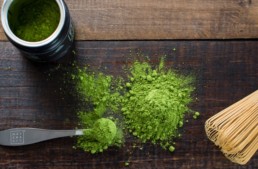
Matcha Tea vs Caffeine: Green tea has long been a dietary staple for individuals in pursuit of better health and wellness.
Every cup is packed with antioxidants, which have been proven to lower the risk of heart disease, improve brain function, support a healthy body weight, and protect against some forms of cancer.
The most common method of preparing green tea is to steep tea leaves in hot water. Bagged tea is particularly popular, though some prefer the flavor and quality afforded by using loose tea leaves with an infuser.
Many people are unaware that there is a third method of brewing tea: creating a finely ground powder from the leaves, then dissolving the powder in hot water. Perhaps this option is virtually unknown, because it fell out of fashion generations ago. However, for centuries, this method of preparation was nearly universal.
In seventh-century China, creating bricks of steamed tea leaves was the only practical way to store and transport large quantities of tea for trade. The standard technique for turning those bricks back into a beverage involved roasting the leaves, grinding them into a powder, and adding the powder to hot water.
Today, this type of tea is enjoying a renaissance. East Asian producers have returned to their roots by growing and preparing matcha – a special green tea leaf that is almost exclusively offered in powdered form.
The flavors and health benefits of matcha have been widely publicized in recent years, and matcha has now officially gone mainstream.
Of course, there are still questions. For example, does matcha offer the same energy boost as other caffeinated beverages? In a head to head matcha tea vs. caffeine contest, which comes out the winner in terms of health benefits?
What is Matcha Tea?
Gaining a clear understanding of what matcha tea is and how it differs from other teas helps in deciding whether to integrate it into your routine.
At its most basic, matcha is a type of green tea. It is grown from the same plant, which is formally known as Camellia Sinensis.
However, aside from belonging to the same family and providing similar types of nutrients, the two are quite different. Everything from how matcha is grown to how it is prepared diverges from traditional green tea, creating a new kind of beverage that offers powerful health benefits.
To start, matcha bushes are grown in shaded areas. As a result, the leaves have a greater concentration of chlorophyll as compared to other green teas.
This is the reason for matcha tea’s bright green color – and the reason matcha offers more nutrients per serving. The shaded period creates a sweeter tea leaf, which contributes to matcha’s distinctive flavor.
Matcha harvesting is done by hand, and then the stems and veins in each leaf are removed. The remaining leafy greens are carefully ground into a fine powder.
The highest quality matcha teas are ground with granite stones, and the process takes place in darkness to maximize retention of nutrients.
Because processing is so labor-intensive, matcha costs more than standard green tea. Within brands of matcha, prices vary widely depending on how true the maker stays to traditional processing.
Is Matcha Tea a Caffeine Alternative?
Green tea is often seen as a coffee alternative for those who want to reduce their intake of caffeine.
When prepared with tea bags or loose tea leaves, the caffeine that remains is quite low. However, matcha tea is a bit different.
Because you consume the entire tea leaf when you prepare tea with matcha powder, there is quite a bit more caffeine in each cup as compared with standard green tea. In some cases, there may be more caffeine than coffee.
Does Matcha Have More Caffeine Than Coffee?
Because the quality and preparation methods of matcha tea vary widely, it’s not possible to make a general statement that matcha has more caffeine than coffee. However, in many cases, this is the case.
Depending on the specific matcha you purchase, how much you dilute the powder, and how you prepare the drink, you may consume anywhere from 35 to 250 milligrams of caffeine per serving.
A standard cup of coffee, on the other hand, has roughly 95 milligrams of caffeine per serving.
The primary difference between consuming caffeine through matcha tea rather than coffee or sugary “energy drinks” is the powerful nutrients that come along with matcha.
So-called energy drinks have no nutritional value whatsoever. Coffee does offer some nutrients, but the value is low as compared to matcha tea.
How To Make Matcha Tea
If you choose to purchase matcha powder and brew your own tea at home, you will discover that the process is nothing like preparing bagged and loose-leaf tea. Instead, you will heat water and whisk or beat the powder in until it is fully dissolved.
Consider the advantages of this method. Rather than consuming the watered down nutrients that remain in your cup after you remove and discard the tea bag, you are consuming the entire tea leaf.
That means your body has access to all of the nutrients in the plant, which boosts the health benefits significantly.
What is the Best Matcha Powder?
Matcha powders are available from a wide variety of retailers, including online sites like Amazon and brick-and-mortar health food stores.
As with any product, the quality of different matcha brands varies dramatically. When choosing the best matcha powder, don’t look for the lowest price.
Higher quality teas are labor-intensive, so you can be sure that a discount matcha wasn’t hand-picked and processed by hand. That isn’t to say that machine-picked and steel-ground matcha should be avoided altogether, but it is important to be aware of what you are buying.
Uji, Japan, is the largest producer of traditional matcha tea, though today, quite a bit is produced in other countries, including China and Argentina.
Be aware of where your tea was grown and processed, and look for one of these three high-quality tea leaves: samidori, yabukita, and okumidori.
Other measurements of matcha quality include color (brighter green is better) and particle size (smaller is better). Amino acid content is also a consideration in grading teas, but it is somewhat more difficult to obtain detailed information across multiple brands.
Keep in mind that western nations tend not to have comprehensive tea grading systems, so disregard marketing claims that profess to be “premium” or similar. It may be a matter of trial and error as you taste-test a selection from your short list of options to choose the matcha tea that’s best for you.
When it comes to matcha tea vs. caffeine in other beverages, matcha wins on nearly every front. It offers a similar jolt of energy as compared to its peers, and then sweetens the deal with a wide array of nutritional benefits.
The key to getting the most from your matcha is choosing a quality brand, then preparing it through the traditional method to maximize your nutrient intake.
What’s Next?
About the author

